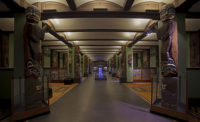To design the first new residential colleges at Yale University since 1963, the Ivy League school has turned within its own ranks.
Class of 1965 alumni Robert A.M. Stern, FAIA, who also is the current dean of the Yale School of Architecture, was selected for the job, university officials announced today. His New York-based firm, Robert A.M. Stern Architects, is known for its expertise in the design of buildings that honor stylistic precedent, particularly in academic settings.
The two buildings Stern is designing for Yale will add 460,000 square feet of space to the New Haven, Connecticut, campus, which has seen a flurry of new construction in recent years. The school expects to break ground on the project, reported to cost nearly $600 million, in 2011 and finish by 2013.
At Yale, each undergraduate is assigned to one of 12 existing residential colleges, which provide social activities and academic guidance, and for most students, a place to live. The two new colleges should allow the university’s undergraduate enrollment to grow by about 800 students, to a total of 6,000, school officials say. The siting of the buildings—next to a cemetery and former canal on a 6.2-acre plot on the campus’s northwestern edge—also is an attempt to physically unite the campus, which unfolds across 320 acres.
The colleges likely will not compromise Yale’s traditional look, which favors a Gothic style, Mr. Stern says. The layout of the new buildings will closely resemble those of James Gamble Rogers, who in the 1930s designed the bulk of Yale’s colleges, whose arched entries open to grassy quadrangles, surrounded by dorm rooms. “He set a very high bar,” says Mr. Stern. “But the new colleges will try to create that same sense of community that’s worked so well.”
In the past five years, the campus has been the site of nearly two dozen projects, many of them high-profile. These include: Malone Center (2005) by Cesar Pelli, who also served as an architecture dean at Yale, from 1977 to 1984; the Yale University Art Gallery, designed by Louis Kahn, which re-opened in 2006 after a three-year restoration; and Paul Rudolph’s Art and Architecture Building, where Stern’s office is located, which recently was rehabbed and enlarged by Gwathmey Siegel and Associates. Moreover, a new home for Yale’s business school will be designed by Lord Norman Foster.For its part, Yale says it considered a few out-of-house proposals for the prestigious commission, “but they were rough ideas, not specific designs,” says Dorie Baker, a spokeswoman, though she declined to provide names. In the end, Stern’s school-rich portfolio helped him edge past the competition, Baker says. For instance, he’s currently designing a new dorm-and-classroom complex at the University of Michigan; this project follows a pair of dormitories Stern recently completed for the Hotchkiss School in Lakeville, Connecticut.
Plus, Stern, who already has consulted on various Yale projects, has a keen appreciation for Yale’s overall context, Baker adds. “He’s very conversant with the needs of Yale’s undergraduates,” she says. “He’s very much steeped in Yale.”



Post a comment to this article
Report Abusive Comment